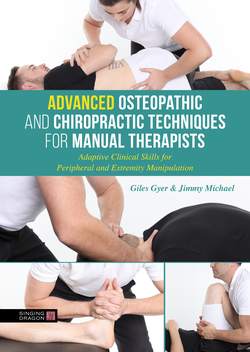Читать книгу Advanced Osteopathic and Chiropractic Techniques for Manual Therapists - Giles Gyer - Страница 12
На сайте Литреса книга снята с продажи.
Significance of ANS changes following manipulation
ОглавлениеAnatomically, the two complementary parts of the ANS include the sympathetic nervous system (SNS) and the parasympathetic nervous system (PNS). The interaction between both these systems is known to influence the stress response of tissues (Cramer and Darby 2013). The SNS plays an active role in mediating the fight-or-flight response and serves as a medium for the efferent communication between the immune system and the central nervous system. It releases catecholamine as an end product, which modulates several immune parameters during acute and chronic inflammation (Elenkov et al. 2000; Pongratz and Straub 2014). The mediating role of SNS between somatic and supportive processes has been demonstrated in Korr’s pioneering work (Korr 2012). In addition, it has also been found that musculoskeletal abnormalities are associated with alterations in cutaneous patterns of sympathetic activity (Korr, Wright and Thomas 1962). In the manual therapy literature, this modulatory effect of the SNS on inflammation has been of special interest, as it may explain some of the neurophysiological effects observed after spinal manipulation. Hence, in the proposed physiological mechanisms of spinal manipulation, a prominent role of the peripheral sympathetic nervous system (PSNS) in the modulation of pain and inflammation has been theorised by both Pickar (2002) and Bialosky et al. (2009).
A number of studies since 2000 have investigated the effects of spinal manipulation on SNS changes. While some studies have reported immediate activation of the SNS following spinal manipulation (Budgell and Polus 2006; Welch and Boone 2008; Win et al. 2015; Zegarra-Parodi et al. 2015), others reported no change in sympathetic activity (Giles et al. 2013; Sillevis et al. 2010; Ward et al. 2013; Younes et al. 2017; Zhang et al. 2006). Welch and Boone (2008) suggested that the autonomic responses observed after manipulation might vary based on the specific segment(s) of the spine manipulated. The authors concluded that sympathetic responses are likely to be elicited from thoracic/lumbar manipulation while parasympathetic responses might result from cervical spine manipulation. Several studies have supported this hypothesis to some extent (Budgell and Polus 2006; Giles et al. 2013; Win et al. 2015). However, contrary findings have also been reported. After measuring the HRV in healthy asymptomatic subjects at two separate time points, Zhang et al. (2006) reported a dominance of the PNS following thoracic manipulation. Recently, using both HRV and baroreflex sensitivity, another study (Ward et al. 2013) conducted on acute back pain patients has also demonstrated increased parasympathetic autonomic control after lumbar manipulation.
However, there were methodological differences between these studies, and no gold-standard technique was used to measure the SNS changes. In addition, the differences in findings were also somewhat dependent on the type of outcome measure used. It appears that the conflicting results mostly came from studies (Budgell and Polus 2006; Giles et al. 2013; Welch and Boone 2008; Ward et al. 2013; Win et al. 2015; Younes et al. 2017; Zhang et al. 2006) that used HRV analysis as a means to determine the nature of autonomic responses after manipulation. The findings of these studies were in favour of either the SNS or PNS. On the other hand, a recent systematic review on post-manipulation SBF changes has reported the presence of a short-term sympathetoexcitatory response (Zegarra-Parodi et al. 2015).
One possible reason for such differences might be the use of the low frequency (LF)/high frequency (HF) ratio as an indicator of ANS activity, where HF represents PNS efferent activity and LF corresponds to both PNS and SNS efferent activity. This method of assessing HRV has been criticised due to oversimplification of the complex non-linear interactions between the SNS and PNS (Billman 2013). More recently, Sampath et al. (2017), using a reliable measure (near-infrared spectroscopy) to assess SNS activity, reported an immediate sympathetic excitation following thoracic manipulation. Interestingly, this study also investigated pre and post manipulation HRV data but found no statistically significant difference between the groups. Nevertheless, the findings of this study need to be interpreted cautiously, as it was based on asymptomatic male subjects, and there has been a report of ANS dysregulation in chronic pain patients. Hence, more research on symptomatic population is warranted.
